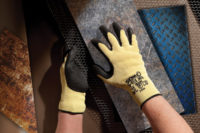For the bread-slicing machine, the uniform and thinner slices of bread meant people ate more slices at a time and ate bread more frequently. The increased consumption of bread resulted in the increased consumption of jam and other spreads to put on the bread.
The iPhone has been called the most innovative product of the past five years. It not only revolutionized the concept of what a phone is; it revolutionized the idea of what a computer is and led to the app store and the app development industry.
From duct tape and WD40, to credit cards, ATMs, the no-iron shirt and Crest White Strips, innovation is all around us. Promoting creativity and innovation leads to amazing products, processes and experiences.
In the personal protection equipment (PPE) industry, we need look no further than our hands. Remember when the only glove choices were leather, cotton, or no glove at all?
Protection drives innovation
The number one reason to wear gloves is to protect hand and fingers. According to the National Safety Council, there are 3.4 billion work-related injuries annually with $156.2 billion spent each year on work-related injuries. Slices, cuts and abrasions account for almost 30 percent of the lost time and productivity in the U.S. and almost 80 percent of these incidents involve the hands, which according to the U.S. Bureau of Labor Statistics, is the leading body part injured on-the-job.
In fact, more than one million U.S. workers receive treatment in emergency departments annually for acute hand and figure injuries. Approximately 110,000 workers with hand and finger injuries lose days from work annually. Many of these injuries are preventable by wearing the proper hand protection. Wearing any glove reduces the risk of hand injury by 27 percent.
The creativity of worker input
In the old macho world of industrial jobs, no one questioned gloves, typically made of leather or cotton, increased worker safety. The problem was getting workers to wear their gloves. Research bore out what those on the front lines knew: wearing gloves increased muscle fatigue, reduced dexterity and decreased the amount of turning force that could be exerted by a worker.
To get workers to wear gloves, manufacturers must understand what workers need in a glove. Today’s glove wearer is looking for a glove with improved attributes relating to longevity, dexterity, comfort, grip and health. Key wants continue to be a need for less hand fatigue, increase hand coverage (3/4 coat, fully coated) protection and no-related irritations or allergic reactions associated to polymer choice of latex, nitrile or neoprene.
The good news: technological innovations introduced over the past several years have greatly improved the performance characteristics of the fabrics and fibers that make up gloves. Today’s workplace gloves are both comfortable and protective. Now gloves feature lighter coatings, greater dexterity, touch sensitivity, and oil absorbency for grip.
Additionally, there are new categories of work gloves that make more gloves job specific to function or application across industry segments and market channels. Now we find gloves that have specific functions with features and benefits designed for contractors, carpenters, HVAC workers, and IBEW millwrights, etc.
These new gloves essentially eliminate old excuses for taking off the gloves because the job is too difficult with gloves on.
Engineered fibers lead the cut-resistant charge
In the glove market, it’s about finding innovative ways to modernize and refresh products in a way that is relevant to the market and delivers significant differentiation. The use of engineered fibers is leading this charge in the category of cut-resistant gloves, which is where we have seen most of the product innovations in the last few years. Two major classes of cut-resistant fibers are aramids, best known by DuPont’s trademarked Kevlar® product, and the high molecular weight polyethylene (HMPE) fibers of Royal SDM N.V.’s Dyneema®. The aramids are more insulative and better for high-temperature applications while the HMPE fibers are typically softer to the touch, cooler for the wearer and often considered the more comfortable of the two classes of fibers.
The functionality of cut-resistant gloves made of engineered fibers is further enhanced by the addition of sponge nitrile, PVC, neoprene, natural rubber latex or polyurethane coatings to add liquid barrier protection and/or wet-dry-oily grip. In addition, some of these gloves have anti-microbial coatings, hi-vis coloration and other special features. Every element in cut-resistant glove equations — from fibers to knitting techniques to coatings — is being fine-tuned for better protection.
Reduce that carbon footprint
One of the more exciting developments in the glove industry is being asked by our customers to be a part of their environmental and sustainability efforts. Conservation of the earth’s natural resources is important. Some major glove manufacturers are incorporating green research and innovation into all their products as a general business practice.
Particularly innovative is the recent introduction of the first biodegradable disposable nitrile glove. The glove has been molecularly engineered to change the structure of nitrile so that it breaks down only when placed in a landfill. While it will biodegrade in a landfill, it retains all the other desirable performance characters of a nitrile glove. Manufacturing gloves that perform the way users need them to, but that don’t harm the environment, is one more way glove manufacturers are innovating.
Conclusion
Ill-fitting gloves with little technology are becoming a thing of the past. Glove companies are designing products focused on the safety and functional requirements of customers. With innovation, product expansion, and a focus on applying technology, glove manufacturers are able to keep pace with workers’ demands. And game-changing technology will continue.


